Anti-glare solutions for pinball machines
Above the playfield is a large piece of glass, that can reflect a lot of the environment. Depending on the lights in your room, this can be a real distraction. Especially if there are lights overhead that you look into directly, these hotspots may blind you and impact your gameplay as you can't follow the ball well.
Luckily there are several solutions for this. Each has their own pros and cons. How much of a difference they make will depend on the location where your game is. Do you play in a dark or a well lit room? Are lights direct above or is it all soft, indirect lightning? How much are you bothered by the reflections?
There are different types of reflections: those of the backbox of the game itself, and reflections of other objects in the room. In this article I'll show you two solutions, anti-reflective playfield glass and privacy filters.
DMD and LCD privacy filters
A main part of the reflections on the back of the playfield, come from the bright dmd or lcd screens in the backbox of the pinball machine itself. The translight itself can also reflect in the playfield glass, but because of its size, a solution for this is more complicated.
Years ago, people came up with the idea of a bent plastic that is installed at the top of the playfield glass.
You can see an example here (aff. link).
I am not a fan of this. It works but it sticks out of the cabinet. At home it could be used, but for location play it's useless and will be
broken or vandalised very soon.
To minimize reflections of the lcd, a much better solution is to install laptop privacy filters can be bought and installed. It costs a little bit more than the bent plastic, but is a much better solution. For almost all recent pinball machines with an lcd screen (Stern, Spooky, ..) you need a 15.6 inch lcd privacy screen. Make sure you buy a privacy filter and not a blue light filter. As you can see in the picture below, they are also available in pinball shops for regular dmds (aff. link).
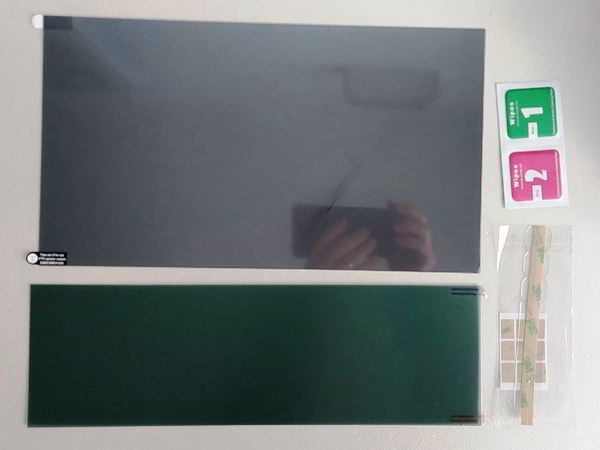
Both types of privacy filter. Still new, with
their dark protective filter on. Usually they come with cleaning pads and small pieces of double sided tape.
You install these directly onto the lcd or dmd glass. They are sort of a miniature grid. The viewing angle of the screen becomes much smaller, they let the light pass directly in front. If you look at the screen from the side, it goes dark, you can't see the display. This helps cut on reflections, as angle of which it bounces off the playfield glass is outside the angle the filter lets pass.
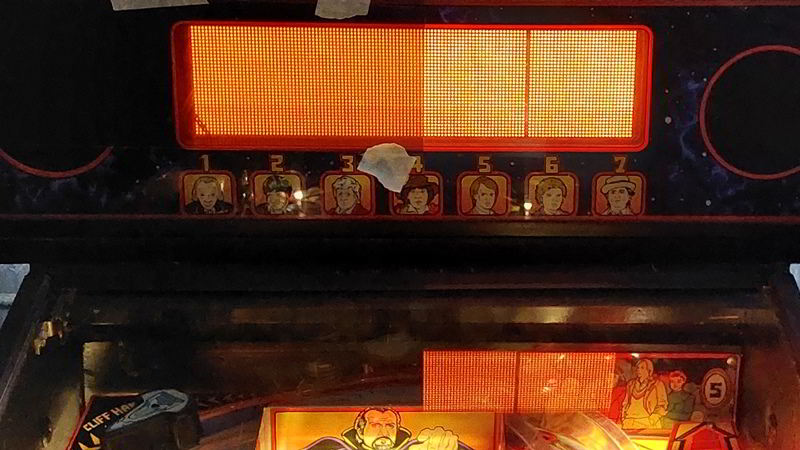
DMD filter halfway installed.
To demonstrate the effect, I've taped a dmd filter halfway over this DrWho dmd. Note this is not how you should install it, it should
go onto the glass itself. The protective foil is still on the filter, making it more dark than it will when it's installed correctly.
As you can see on the bottom part of the picture, the reflection on the playfield glass is gone in the part that's covered by a filter.
The 5th doctor plastic is partly invisible, while the left side of the backpanel remains completely visible.
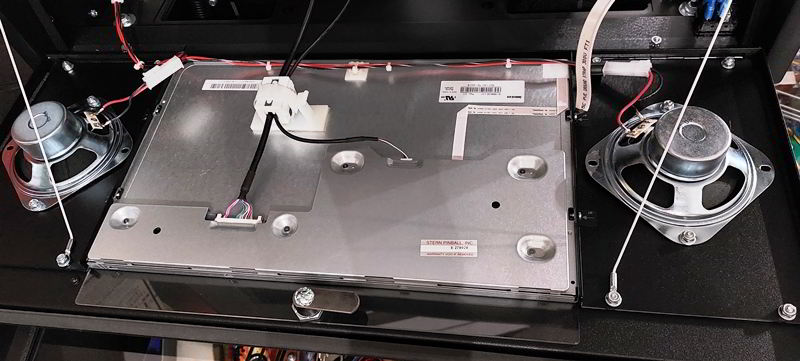
Installation on a Stern game is easy: open the backbox
and unscrew the lcd with 2 screws on each side. Clean the lcd, stick the privacy filter on with the included double sided tape,
and assemble again.
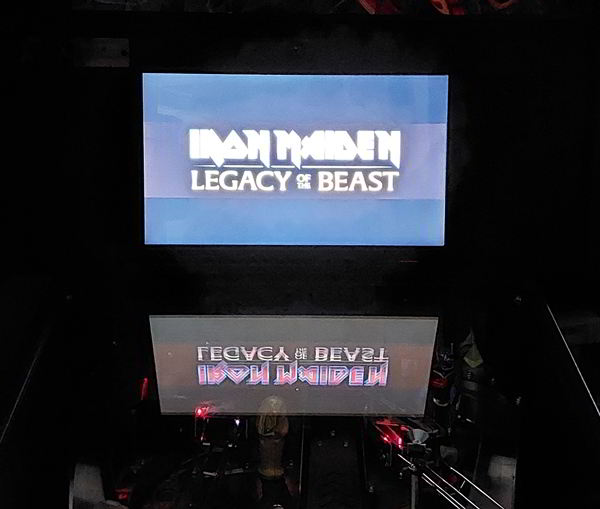
This is the before picture: no privacy filter installed,
and a regular playfield glass.
Notice the large reflection of the startup screen.
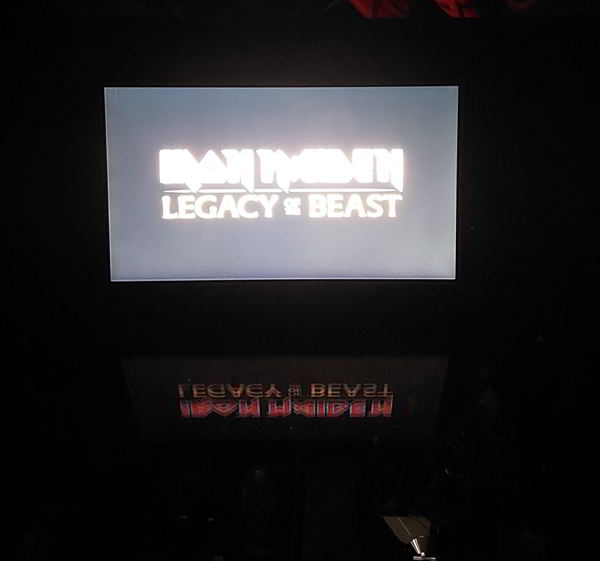 Privacy filter and anti-reflective glass installed.
Privacy filter and anti-reflective glass installed.
The reflection is almost totally gone, in a dark environment.
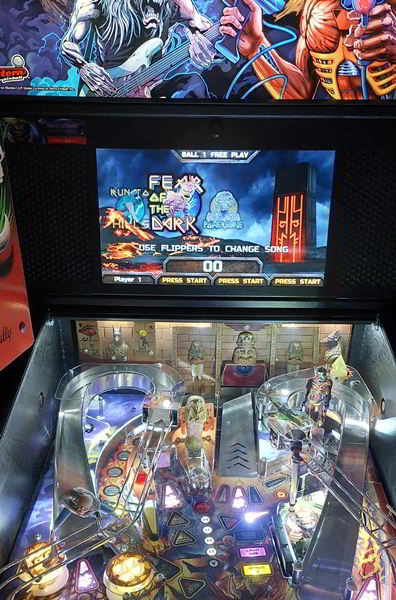 The pictures above with a dark playfield show the worst condition
possible. Once the game has booted and the playfield is lit, no reflections are visible anymore. In a bright room they will also
be less noticeable.
The pictures above with a dark playfield show the worst condition
possible. Once the game has booted and the playfield is lit, no reflections are visible anymore. In a bright room they will also
be less noticeable.
I really love these privacy filters and have them installed on all my machines. For less than $20 each, they're one of the best
and cheapest solutions you can do to block reflections and make your game look better.
Not all games may need it. Some WPC games just have a black wooden backpanel. The reflection usually doesn't disturb a lot.
Games like Monster Bash and Cactus Canyon have beautiful plastic, they look much better with such a filter installed,
as you can then always see the artwork.
The only disadvantage is that these filters make the display / lcd a bit darker. Only a little bit, and it's not really noticeable if
you have them installed on all your games.
Backglass filters
I don't have examples of them, but there are anti-reflective plexi panels available for the whole translight.
I find them very expensive for the limited added value they provide.
A cheaper solution is to dim the backbox,
most games (WPC and Stern Spike) have a setting in which you can dim the illumination of the backbox. Set it to its lowest
setting and this will help a lot, especially together with an anti-reflective playfield glass.
Anti-reflective playfield glass
Not all reflections come from the dmd or lcd. Often other sources in the room reflect on the playfield glass. To counter this, you can buy anti-reflective playfield glass. In the past there were only a few sources, Roman glass from Germany was best known. Now most pinball manufacturers have their version (Invisiglass, ..) and there are many providers of this type of glass.
I will not start comparing the different types and source of glass here. There are different graduations and types of quality.
More expensive is not always better. The differences between the sources will be in:
- amount of reflection: some reflect less than other,
- tint of the glass: some are really clear, other have a slight green, purple or blue tint,
- anti-reflection technique and durability: with some the special layer is inside the glass, with other it's a coating on one or both
sides of the glass.
Cons of anti-reflective playfield glass:
- They're expensive, $150 - $200 on average.
- They're fragile. Fingerprints show more easily on them. Cleaning them using the wrong cloth or solution can damage them.
- Their effect may be less noticeable depending on your gameroom (light or dark, position of light sources, ..)
Advantage:
- They are great :)
- They really cut reflections a lot. And in my opinion what is even a better, especially if
you don't care about reflections, is that a good quality anti-reflective glass looks like it's invisible. The colors of the
playfield will look much brighter and better, there is more contrast. Your expensive playfield will look a lot better.
- They're easily taken out. If you want to sell your machine, install the original glass, and use your anti-reflective glass in another machine.
Below are some examples of the effect of anti-reflective glass.
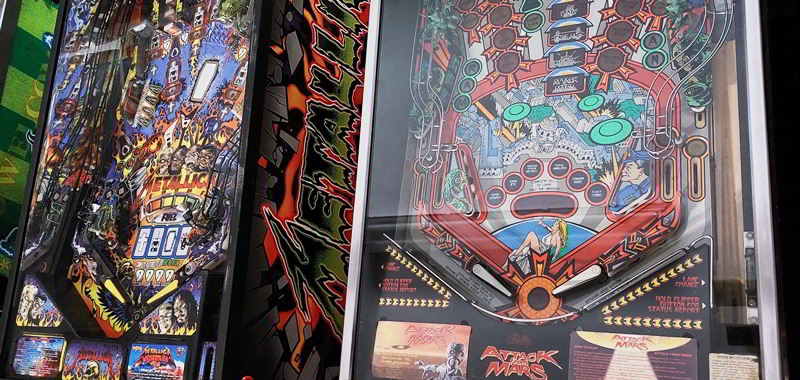
Here you see both types of glass. Attack From Mars on the right has regular playfield glass. The white ceiling is reflected a lot.
Everything on the playfield itself looks more flat.
The Metallica pinball on the left has an anti-glare glass. There is no reflection at all of the ceiling, colors are
much brighter.

Don't be mistaken, anti-reflection glass does not stop all direct reflections. If there are light sources directly above your game, you will still see them.
They will reflect much less. Here you see how much the overhead light reflects in each type of glass.
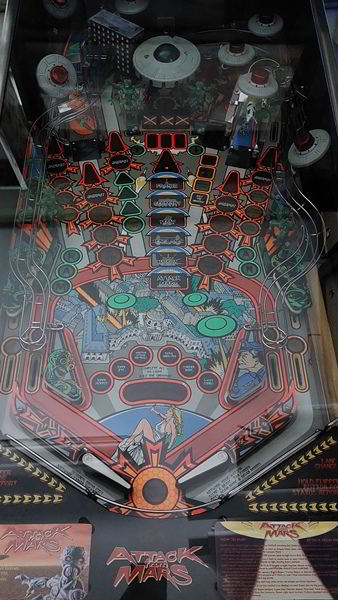 Regular playfield glass.
Regular playfield glass.
 Anti reflective glass installed. Both games are next to
each other, pictures taken in identical conditions.
Anti reflective glass installed. Both games are next to
each other, pictures taken in identical conditions.
The difference is really amazing, it looks as if there is no glass installed! The colors are really bright, you have a better view during gameplay. It's difficult
to explain, but this games looks more in 3D, with a regular glass installed everything it looks flatter.
